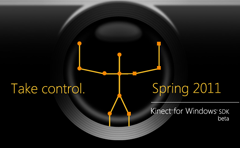Microsoft Offers Commercial Kinect Developer Kit

Microsoft is to allow developers to build business apps using its hands-free Kinect gaming kit
Microsoft is to exploit the success of its hands-free Kinect gaming kit among consumers, after announcing it is developing a Kinect for Windows commercial program for early 2012.
In a press release, the company described the program as a way to give “global businesses the tools they need to develop applications on Kinect that could take their businesses and industries in new directions.”
Some 200 businesses, including 25 companies in the Fortune 500, are already involved in a “global” pilot program designed to explore the technology’s commercial ramifications.
Business Apps
Microsoft had originally designed the Kinect controller as a way to play Xbox 360 games via gesture and the spoken word, targeting those casual gamers who’d made the Nintendo Wii and its unconventional, gesture-centric controllers such an enormous hit. Within weeks of Kinect’s release in November 2010, however, tech pros found a way to hack the Kinect’s 3D camera. Soon videos began to appear on YouTube, demonstrating how the next-generation hardware could do everything from control robots to paint 3D images.
At first, Microsoft did not approve. “Microsoft does not condone the modification of its products,” a company spokesperson told CNET that November. “Microsoft will continue to make advances in these types of safeguards and work closely with law enforcement and product safety groups to keep Kinect tamper-resistant.”
 However, before Microsoft’s legal counsel could click “Print” on those cease-and-desist letters, the company executed an abrupt about-face and embraced the Kinect hacking, claiming that it had deliberately left the device open to modification.
However, before Microsoft’s legal counsel could click “Print” on those cease-and-desist letters, the company executed an abrupt about-face and embraced the Kinect hacking, claiming that it had deliberately left the device open to modification.
“Hacking would mean that someone got to our algorithms that sit on the side of the Xbox and was able to actually use them, which hasn’t happened,” Alex Kipman, Microsoft’s director of incubation for the Xbox, told NPR in a 19 November, 2010, interview. “What has happened is someone wrote an open-source drive for PCs that essentially opens the USB connection, which we didn’t protect by design, and reads the inputs from the sensor.”
Beyond Gaming
Microsoft then started highlighting its intention to offer Kinect’s technology to academic institutions, with an eye toward boosting the latter’s research.
At the same time, the company also hinted that it intended to expand its work in 3D sensing to products beyond gaming. In late 2010, it acquired Canesta, a maker of 3D-image sensor chips that camera modules that can be embedded in a variety of consumer products, including laptops and vehicle dashboards.
The next step, apparently, involves creating a sandbox for companies to innovate atop Kinect, and maybe create applications where gesture control comes in particularly handy.